Moving a household means many details, moving parts and possible mistakes. We’ve written a bit before about how to keep yourself and your movers safe. As a companion question, what are safe moving techniques for your items?
Protecting Large Items
Our team at My Small Moves is very familiar with moving furniture. These key pieces of a household are a high priority when it comes to space, safety and procedure. As with so many other aspects of moving, proper planning is important. You need proper gear, procedure and space. Small local movers often have specialized gear that makes this process much smoother.
Furniture sliders are a good way to scoot your large furniture around. These discs placed between your furniture ground contact points and the floor reduce friction and allow simple sliding with a careful push. When you need to move the furniture through doorways and into different rooms or buildings, you may need some new gear and tactics, from tools to padding and shrink wrap. It’s often wise to get help from local movers, Salt lake City being no exception.
When possible, it is often useful to find ways to disassemble larger objects into more manageable pieces. Not all furniture is designed well for easy disassembly and subsequent reassembly, unfortunately, but it is worth checking your furniture to see what can be done. Even something as simple as removing the legs from your couch can make transport safer and simpler. Sectional couches are well suited for this. Some recliners can have their back section separated from the base. Some couches can have their arms removed. Some desks can have their legs or sides removed. Some cabinets can be separated into upper and lower sections. Drawers may be removed.

Notably, it may not always be best to remove smaller parts, especially things like cabinet doors. Closing and securing them helps prevent unwanted motion and damage. It is wise to empty out furniture when possible, though. An empty desk or cabinet will be much easier to move, and your goods that were inside can be protected better in smaller boxes with proper padding, which we’ll address below.
Once your larger furniture is emptied and segmented as appropriate, you can move on to padding and wrapping. This is an optional step for those pieces that need an extra layer of protection. High durability padding blankets are a specialized tool for this purpose, and Salt Lake City movers will be well stocked. The principle is the same with whatever sorts of cloth you use for padding. You want it to be tough but flexible to protect against tears and abrasion, and padded to prevent surface damage to your furniture. Arrange the cloth padding around your surfaces and structural elements you want protected, especially corners and areas that might run into wall corners or door frames as the pieces are moved through your spaces. Make sure to give some thought to how they are going to be packaged together in your moving vehicle. There are several options for securing these cloths, the most common being ropes or plastic shrink wrap. This padding procedure does take time and effort, but for those pieces that need to be protected, it is time and preparation well spent.
Protecting Drawers And Shelves
Drawers and shelves often have loose items that are at risk in moving. They also can themselves be loose or movable, or even just heavy, which can be a problem for moving furniture. It is often best to remove drawers before moving furniture so that the furniture is lighter and free of moving parts. Loose shelves are also best to remove, as well as any loose pins that were holding them. This will require more organization, so you may wish to label your items by writing on a bit of masking tape or painter’s tape and securing it to the drawers and/or shelves and their source furniture.
Some drawers, like silverware drawers, can simply be prepared by wrapping them with plastic wrap, keeping their contents contained. Other drawers are best to empty into some of your packing boxes to maintain organization or more tightly secure certain items. Drawers in some furniture cannot be removed, so it’s often best in that case to put the contents in a packing box, and secure the drawer so that it cannot move while you move the furniture.

Boxes
Boxes will often be a large part of moving plans. They are great for oddly shaped items or collections of items that would be otherwise troublesome to keep track of. Make sure your boxes are sturdy and well taped. The team at My Small Moves, your local Salt Lake City Movers, can help you find a good source for boxes. Tape the bottom of your boxes along the edge where the flaps meet, then again across that seam, to give extra strength. This is especially important for the bottom of your boxes. Do not overload your cardboard boxes, as they will be more difficult to move safely. 30 pounds is a good upper limit to stay within.
You may need packing material inside of your boxes to protect your items. Fragile items may require bubble wrap, packing paper, packing peanuts (styrofoam pellets) or even simple cloth to prevent them from moving and breaking. Care in this preparation will prevent problems. It is also important to label your boxes so you can remember to exert extra care with heavier and more fragile boxes.
When organizing and stacking boxes, put your heaviest and sturdiest boxes on the bottom of any stack, and the lightest and most fragile on the top. Do not overload your lower boxes, and make sure your stacks are securely balanced to prevent falls and breakage.
With these packing tips, your belongings have a better chance of arriving to their destination intact and undamaged. My Small Moves brings moving blankets and shrink wrap that they’ll use to protect your furniture and breakable items such as mirrors. Use of shrink wrap and moving blankets are free of charge. Their Salt Lake City Movers bring all the necessary moving equipment and skill to safely move your furniture. Please call My Small Moves or fill out their free quote today!
